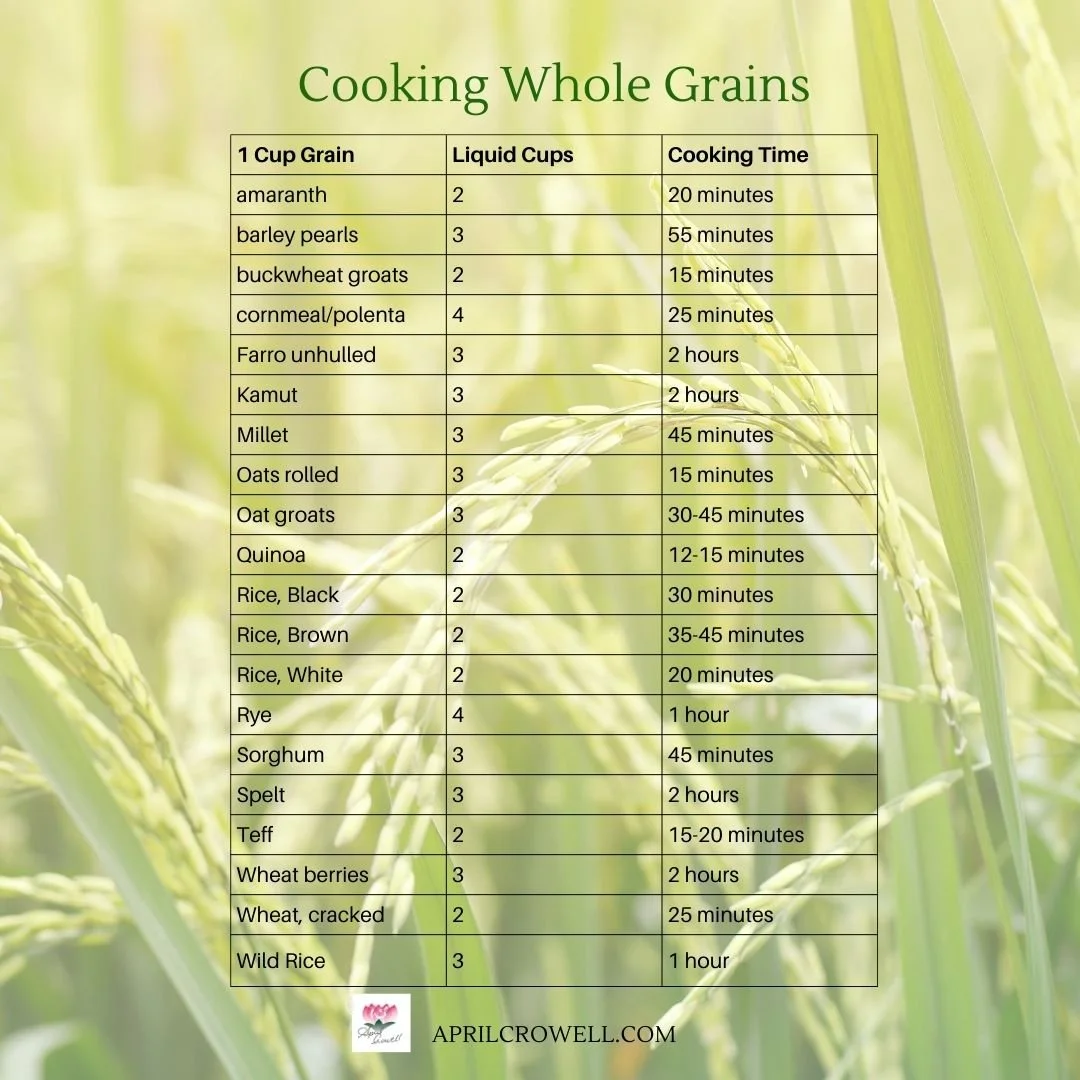Cooking With Whole Grains
Whole grains have been an integral part of our diets since we first started cultivating the Fertile Crescent, about 10,000 years ago. Along with lentils and legumes, whole grains should still be an essential part of our diets today. They provide essential vitamins, minerals, proteins and complex carbohydrates.
Presently, many fad diets have vilified grains in our diets. The biggest problem actually comes from processed and refined grains not whole grains. Carbohydrates got a bad rap. To create energy we need carbohydrates, the problem is highly processed grains like pastas and flours break down too fast in the digestive tract. Complex carbohydrates - once called long chain carbohydrates - take longer to break down in the body. Now often referred to as 'resistant carbs' they are digested in the small intestines and the large intestines. This prevents insulin spikes and creates long, sustained energy. Whole grains still have their bran still intact and require cooking to make the food digestible. In my eyes, there is no way a bread can be "whole grain" - it has been milled and refined to make flour. Unlike eating actual wheat berries that need soaked and then cooked to be eaten. On occasion, I may recommend a client cut out whole grains to meet a specific nutritional goal, but I never recommend cutting them out for long. Besides whole grains being packed with vitamins, minerals and proteins, they contain bran and complex carbs. To reiterate, complex carbohydrates create energy, and the more complex, the longer it takes the body to break it down, the more it stabilizes the blood sugar to create lasting energy. It's the simple carbs that create chaos in our systems.
An overview of grain's nutrition and energetics
Each grain also contains its own energetics according to Chinese medicine and benefits different systems in the body. However, we can talk about them in some broad general terms. Grains anchor the body, provide strength and endurance. Their sweet, warming nature heals the Stomach and Spleen and benefit the Earth element. However, eating overly processed and refined grains does the opposite. The more whole the form of grain, the more beneficial it is to the body. I will save that energetics of each for a later blog, but you can read about the energetics of gluten free grains here.
Despite rumors, grains are easy to prepare. All you have to do is soak and rinse to remove the phytates (a hard to digest compound), and then cook them in liquid until they are tender and swollen. Most grains grow to at least double their size while others may grow to 3-4 times their size.
Some Grain basics
Grains are made up of three basic parts.
The germ: an important source of vitamin E, contains vitamins, oils, and protein.
The endosperm: made up of starch granules, has walls made mostly of protein.
The bran: composed of minerals, fiber, protein, and some vitamins. Processed grains and flours will remove most of the bran and valuable fiber and protein with it.
Milled grains, or those not in their whole form should be refrigerated or frozen to prevent rancidity.
What about psuedo grains?
Ah…labeling and semantics. The word ‘grain’ is commonly used to refer to both the edible fruit from grassy plants (rice, wheat, barley) and the seed crops (amaranth, millet, quinoa). Both categories of crops are used as staple foods, both are cooked very similarly, but they are different botanically. Grasses are monocots (leaves with parallel grains). Seed crops come from dicots which are broad leafed plants.
Basic cooking for grains
Wash the grains thoroughly by rinsing in cold water until water is clear. This removes dirt and grit and starts the swelling process. Use the rinse water to water your garden.
In a large pan (make sure it is big enough to accommodate the grain doubling or tripling in size) with a tight fitting lid, bring cooking liquid to a boil. The liquid can be broth, water, milk or juice. Whatever liquid you choose will flavor the grain.
Add in grain and stir once.
Bring liquid back to a boil and then reduce to lowest heat setting that will allow simmering. Simmer grain slowly. Cooking times vary for grains from a mere 15 minutes to 2 hours. See chart below.
To see if the grain is cooked, pull out a small amount and taste. The grain should be chewy, not hard or pasty. Add more liquid and continue cooking if necessary.
Rice cookers and Instapots are fantastic ways to cook grains.
Other methods of cooking whole grains
Pilaf method—Sauté the grain in oil, possibly with onions, carrots, and celery and then add stock or water. Usually add 2 times the amount of water to grain. Cover over and cook over medium heat until liquid is absorbed and the grain is tender. This method is great for summer grain salads.
Baking method —A wonderful way to bring out each grain's flavor. Sauté grain in a skillet with oil for about 1 minute. Add grain and appropriate amount of cooking liquid to heavy Dutch oven or other oven safe cooking dish with a tight fitting lid. Bake in a 400 degree oven for about the same amount of time as the stove top method.
Thermos method —Ideal for the "I don't have time for breakfast" crew. Portion a uncooked portion of selected grain into a thermos. Add in boiling or broth, appropriate to selected grain. For example, rice is 1 cup rice to 2 cups water - and so on. Stir to move liquid through the grain. Close thermos and let stand for about 8-10 hours. Breakfast is ready....






